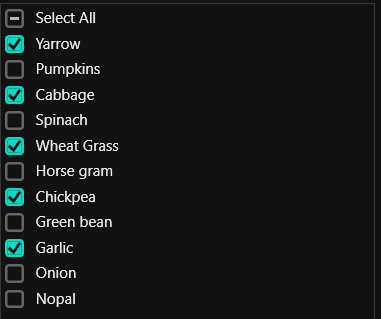Appearance in WPF CheckedListBox (CheckListBox)
4 May 202124 minutes to read
This section explains different UI customization, styling, theming options available in CheckListBox control.
Setting the Foreground
We can change the foreground color of CheckListBox items by setting the Foreground property. The default color value of Foreground property is Black.
<syncfusion:CheckListBox Foreground="Red"
Name="checkListBox">
<syncfusion:CheckListBoxItem Content="Mexico"/>
<syncfusion:CheckListBoxItem Content="Canada" />
<syncfusion:CheckListBoxItem Content="Bermuda" />
<syncfusion:CheckListBoxItem Content="Belize" />
<syncfusion:CheckListBoxItem Content="Panama" />
</syncfusion:CheckListBox>CheckListBox checkListBox = new CheckListBox();
checkListBox.Items.Add( new CheckListBoxItem() { Content = "Mexico" });
checkListBox.Items.Add( new CheckListBoxItem() { Content = "Canada" });
checkListBox.Items.Add( new CheckListBoxItem() { Content = "Bermuda" });
checkListBox.Items.Add( new CheckListBoxItem() { Content = "Belize" });
checkListBox.Items.Add( new CheckListBoxItem() { Content = "Panama" });
//Setting the foreground brush
checkListBox.Foreground=Brushes.Red;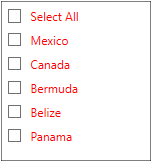
Setting the Background
We can change the background color of CheckListBox items by setting the Background property. If we want to differentiate mouse hovered item or currently selected item with other items, we can do this by using MouseOverBackground and SelectedItemBackground properties.
<syncfusion:CheckListBox Background="SkyBlue"
MouseOverBackground="DeepPink"
SelectedItemBackground="Yellow"
Name="checkListBox">
<syncfusion:CheckListBoxItem Content="Mexico"/>
<syncfusion:CheckListBoxItem Content="Canada" />
<syncfusion:CheckListBoxItem Content="Bermuda" />
<syncfusion:CheckListBoxItem Content="Belize" />
<syncfusion:CheckListBoxItem Content="Panama" />
</syncfusion:CheckListBox>CheckListBox checkListBox = new CheckListBox();
checkListBox.Items.Add( new CheckListBoxItem() { Content = "Mexico" });
checkListBox.Items.Add( new CheckListBoxItem() { Content = "Canada" });
checkListBox.Items.Add( new CheckListBoxItem() { Content = "Bermuda" });
checkListBox.Items.Add( new CheckListBoxItem() { Content = "Belize" });
checkListBox.Items.Add( new CheckListBoxItem() { Content = "Panama" });
//Setting various background.
checkListBox.Background = Brushes.SkyBlue;
checkListBox.MouseOverBackground = Brushes.DeepPink;
checkListBox.SelectedItemBackground = Brushes.Yellow;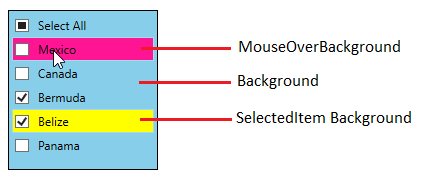
Change flow direction
We can change the flow direction of the CheckListBox layout from right to left by setting the FlowDirection property value as RightToLeft. The Default value of FlowDirection property is LeftToRight.
<syncfusion:CheckListBox FlowDirection="RightToLeft"
Name="checkListBox">
<syncfusion:CheckListBoxItem Content="Mexico"/>
<syncfusion:CheckListBoxItem Content="Canada" />
<syncfusion:CheckListBoxItem Content="Bermuda" />
<syncfusion:CheckListBoxItem Content="Belize" />
<syncfusion:CheckListBoxItem Content="Panama" />
</syncfusion:CheckListBox>CheckListBox checkListBox = new CheckListBox();
checkListBox.Items.Add( new CheckListBoxItem() { Content = "Mexico" });
checkListBox.Items.Add( new CheckListBoxItem() { Content = "Canada" });
checkListBox.Items.Add( new CheckListBoxItem() { Content = "Bermuda" });
checkListBox.Items.Add( new CheckListBoxItem() { Content = "Belize" });
checkListBox.Items.Add( new CheckListBoxItem() { Content = "Panama" });
//Setting flow direction as RTL
checkListBox.FlowDirection = FlowDirection.RightToLeft;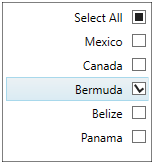
NOTE
Item Template
We change the DataTemplate of the each CheckListBox items by using the ItemTemplate property.
//Model.cs
class Vegetable {
public string Category { get; set; }
public int Price { get; set; }
public string Name { get; set; }
}
//ViewModel.cs
class ViewModel {
public ObservableCollection<Vegetable> Vegetables { get; set; }
public ViewModel() {
Vegetables = new ObservableCollection<Vegetable>();
Vegetables.Add(new Vegetable { Price=10, Name="Yarrow", Category="Leafy and Salad" });
Vegetables.Add(new Vegetable { Price=20, Name="Pumpkins", Category="Leafy and Salad" });
Vegetables.Add(new Vegetable { Price=30, Name="Cabbage", Category="Leafy and Salad" });
Vegetables.Add(new Vegetable { Price=10, Name="Spinach", Category="Leafy and Salad" });
Vegetables.Add(new Vegetable { Price=20, Name="Wheat Grass", Category="Leafy and Salad" });
Vegetables.Add(new Vegetable { Price=30, Name="Horse gram", Category="Beans" });
Vegetables.Add(new Vegetable { Price=10, Name="Chickpea", Category="Beans" });
Vegetables.Add(new Vegetable { Price=20, Name="Green bean", Category="Beans" });
Vegetables.Add(new Vegetable { Price=30, Name="Garlic", Category="Bulb and Stem" });
Vegetables.Add(new Vegetable { Price=10, Name="Onion", Category="Bulb and Stem" });
Vegetables.Add(new Vegetable { Price=20, Name="Nopal", Category="Bulb and Stem" });
}
}<syncfusion:CheckListBox x:Name="ListBox"
ItemsSource="{Binding Vegetables}">
<syncfusion:CheckListBox.DataContext>
<local:ViewModel></local:ViewModel>
</syncfusion:CheckListBox.DataContext>
<!--DataTemplate for the CheckListBox items-->
<syncfusion:CheckListBox.ItemTemplate>
<DataTemplate>
<StackPanel Orientation="Horizontal">
<TextBlock FontWeight="Bold"
Foreground="SkyBlue"
Text="{Binding Name}" />
</StackPanel>
</DataTemplate>
</syncfusion:CheckListBox.ItemTemplate>
</syncfusion:CheckListBox>
Group Template
We change the DataTemplate of the group header items by using the GroupTemplate property.
//Model.cs
class Vegetable {
public string Category { get; set; }
public int Price { get; set; }
public string Name { get; set; }
}
//ViewModel.cs
class ViewModel {
public ObservableCollection<Vegetable> Vegetables { get; set; }
public ICommand LoadedCommand { get; set; }
public void OnLoaded(object param) {
CollectionView view = (CollectionView)CollectionViewSource.GetDefaultView(Vegetables);
//Adding group description
view.GroupDescriptions.Add(new PropertyGroupDescription("Category"));
}
public ViewModel() {
Vegetables = new ObservableCollection<Vegetable>();
Vegetables.Add(new Vegetable { Price=10, Name="Yarrow", Category="Leafy and Salad" });
Vegetables.Add(new Vegetable { Price=20, Name="Pumpkins", Category="Leafy and Salad" });
Vegetables.Add(new Vegetable { Price=30, Name="Cabbage", Category="Leafy and Salad" });
Vegetables.Add(new Vegetable { Price=10, Name="Spinach", Category="Leafy and Salad" });
Vegetables.Add(new Vegetable { Price=20, Name="Wheat Grass", Category="Leafy and Salad" });
Vegetables.Add(new Vegetable { Price=30, Name="Horse gram", Category="Beans" });
Vegetables.Add(new Vegetable { Price=10, Name="Chickpea", Category="Beans" });
Vegetables.Add(new Vegetable { Price=20, Name="Green bean", Category="Beans" });
Vegetables.Add(new Vegetable { Price=30, Name="Garlic", Category="Bulb and Stem" });
Vegetables.Add(new Vegetable { Price=10, Name="Onion", Category="Bulb and Stem" });
Vegetables.Add(new Vegetable { Price=20, Name="Nopal", Category="Bulb and Stem" });
//Initialize the checklistbox LoadedCommand
LoadedCommand = new DelegateCommand<object>(OnLoaded);
}
}<syncfusion:CheckListBox x:Name="ListBox"
ItemsSource="{Binding Vegetables}"
DisplayMemberPath="Name">
<syncfusion:CheckListBox.DataContext>
<local:ViewModel></local:ViewModel>
</syncfusion:CheckListBox.DataContext>
<i:Interaction.Triggers>
<i:EventTrigger EventName="Loaded">
<i:InvokeCommandAction Command="{Binding LoadedCommand}" />
</i:EventTrigger>
</i:Interaction.Triggers>
<!--DataTemplate for the GroupHeader items-->
<syncfusion:CheckListBox.GroupTemplate>
<DataTemplate>
<TextBlock Text="{Binding Name}"
Foreground="Green"
FontWeight="Bold">
</TextBlock>
</DataTemplate>
</syncfusion:CheckListBox.GroupTemplate>
</syncfusion:CheckListBox>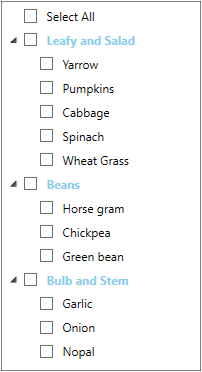
SelectAll Template
We change the DataTemplate of the SelectAll item by using the SelectAllTemplate property.
//Model.cs
class Vegetable {
public string Category { get; set; }
public int Price { get; set; }
public string Name { get; set; }
}
//ViewModel.cs
class ViewModel {
public ObservableCollection<Vegetable> Vegetables { get; set; }
public ViewModel() {
Vegetables = new ObservableCollection<Vegetable>();
Vegetables.Add(new Vegetable { Price=10, Name="Yarrow", Category="Leafy and Salad" });
Vegetables.Add(new Vegetable { Price=20, Name="Pumpkins", Category="Leafy and Salad" });
Vegetables.Add(new Vegetable { Price=30, Name="Cabbage", Category="Leafy and Salad" });
Vegetables.Add(new Vegetable { Price=10, Name="Spinach", Category="Leafy and Salad" });
Vegetables.Add(new Vegetable { Price=20, Name="Wheat Grass", Category="Leafy and Salad" });
Vegetables.Add(new Vegetable { Price=30, Name="Horse gram", Category="Beans" });
Vegetables.Add(new Vegetable { Price=10, Name="Chickpea", Category="Beans" });
Vegetables.Add(new Vegetable { Price=20, Name="Green bean", Category="Beans" });
Vegetables.Add(new Vegetable { Price=30, Name="Garlic", Category="Bulb and Stem" });
Vegetables.Add(new Vegetable { Price=10, Name="Onion", Category="Bulb and Stem" });
Vegetables.Add(new Vegetable { Price=20, Name="Nopal", Category="Bulb and Stem" });
}
}<syncfusion:CheckListBox x:Name="ListBox"
ItemsSource="{Binding Vegetables}"
DisplayMemberPath="Name">
<syncfusion:CheckListBox.DataContext>
<local:ViewModel></local:ViewModel>
</syncfusion:CheckListBox.DataContext>
<!--DataTemplate for the SelectAll items-->
<syncfusion:CheckListBox.SelectAllTemplate>
<DataTemplate>
<TextBlock FontWeight="Bold"
Foreground="SkyBlue"
Text="Select All"
FontStyle="Italic"/>
</DataTemplate>
</syncfusion:CheckListBox.SelectAllTemplate>
</syncfusion:CheckListBox>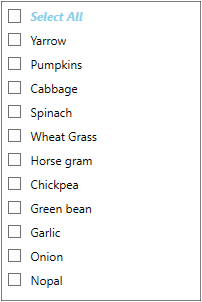
NOTE
ItemContainerStyle
We can change the item container style of CheckListBox by using the ItemContainerStyle which is applied to the container element that generated for each item. The default value of ItemContainerStyle is null.
class ViewModel {
private ObservableCollection<string> daysCollection = new ObservableCollection<string>();
public ObservableCollection<string> DaysCollection {
get { return daysCollection; }
set { daysCollection = value; }
}
public ViewModel() {
//Days added in the collection
DaysCollection.Add("Sunday");
DaysCollection.Add("Monday");
DaysCollection.Add("Tuesday");
DaysCollection.Add("Wednesday");
DaysCollection.Add("Thursday");
DaysCollection.Add("Friday");
DaysCollection.Add("Saturday");
}
}<syncfusion:CheckListBox ItemsSource="{Binding DaysCollection}" x:Name="checkListBox">
<syncfusion:CheckListBox.DataContext>
<local:ViewModel></local:ViewModel>
</syncfusion:CheckListBox.DataContext>
<!--Setting ItemContainerStyle for the CheckListBoxItems-->
<syncfusion:CheckListBox.ItemContainerStyle>
<Style TargetType="syncfusion:CheckListBoxItem">
<Style.Triggers>
<Trigger Property="IsChecked" Value="True">
<Setter Property="FontWeight" Value="Bold"></Setter>
</Trigger>
</Style.Triggers>
</Style>
</syncfusion:CheckListBox.ItemContainerStyle>
</syncfusion:CheckListBox>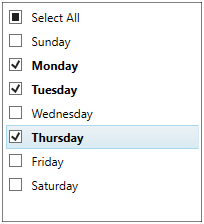
Here, the Checked items are contains a bold font.
NOTE
ItemTemplateSelector
We can change the various DataTemplate for the CheckListBox items based on the provided logic by using the ItemTemplateSelector.
//Model.cs
public class Vegetable {
public string Category { get; set; }
public int Price { get; set; }
public string Name { get; set; }
}
//ViewModel.cs
class ViewModel {
public ObservableCollection<Vegetable> Vegetables { get; set; }
public ICommand LoadedCommand { get; set; }
public void OnLoaded(object param) {
CollectionView view = (CollectionView)CollectionViewSource.GetDefaultView(Vegetables);
//Adding group description
view.GroupDescriptions.Add(new PropertyGroupDescription("Category"));
}
public ViewModel() {
Vegetables = new ObservableCollection<Vegetable>();
Vegetables.Add(new Vegetable { Price=10, Name="Yarrow", Category="Leafy and Salad" });
Vegetables.Add(new Vegetable { Price=20, Name="Pumpkins", Category="Leafy and Salad" });
Vegetables.Add(new Vegetable { Price=30, Name="Cabbage", Category="Leafy and Salad" });
Vegetables.Add(new Vegetable { Price=10, Name="Spinach", Category="Leafy and Salad" });
Vegetables.Add(new Vegetable { Price=20, Name="Wheat Grass", Category="Leafy and Salad" });
Vegetables.Add(new Vegetable { Price=30, Name="Horse gram", Category="Beans" });
Vegetables.Add(new Vegetable { Price=10, Name="Chickpea", Category="Beans" });
Vegetables.Add(new Vegetable { Price=20, Name="Green bean", Category="Beans" });
Vegetables.Add(new Vegetable { Price=30, Name="Garlic", Category="Bulb and Stem" });
Vegetables.Add(new Vegetable { Price=10, Name="Onion", Category="Bulb and Stem" });
Vegetables.Add(new Vegetable { Price=20, Name="Nopal", Category="Bulb and Stem" });
//Initialize the checklistbox LoadedCommand
LoadedCommand = new DelegateCommand<object>(OnLoaded);
}
}
//ItemTemplateSelector class for select a DataTemplate
public class MyTemplateSelector : DataTemplateSelector {
public DataTemplate Template { get; set; }
public DataTemplate itemTemplate { get; set; }
public override DataTemplate SelectTemplate(object item, DependencyObject container) {
if (item is Vegetable && (item as Vegetable).Category == "Beans")
return itemTemplate;
else
return Template;
}
}<Window.Resources>
<local:MyTemplateSelector x:Key="Mytemplate">
<local:MyTemplateSelector.Template>
<DataTemplate>
<TextBlock Text="{Binding Name}" FontWeight="Bold"></TextBlock>
</DataTemplate>
</local:MyTemplateSelector.Template>
<local:MyTemplateSelector.itemTemplate>
<DataTemplate>
<TextBlock Text="{Binding Name}" FontStyle="Italic"></TextBlock>
</DataTemplate>
</local:MyTemplateSelector.itemTemplate>
</local:MyTemplateSelector>
</Window.Resources>
<syncfusion:CheckListBox ItemTemplateSelector="{StaticResource Mytemplate}"
ItemsSource="{Binding Vegetables}"
Name="checkListBox">
<syncfusion:CheckListBox.DataContext>
<local:ViewModel></local:ViewModel>
</syncfusion:CheckListBox.DataContext>
<i:Interaction.Triggers>
<i:EventTrigger EventName="Loaded">
<i:InvokeCommandAction Command="{Binding LoadedCommand}" />
</i:EventTrigger>
</i:Interaction.Triggers>
</syncfusion:CheckListBox>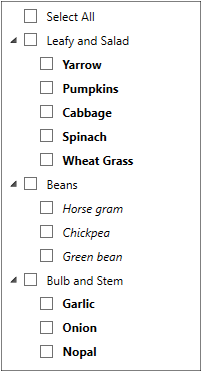
Here, the Leaf and Salad and Bulb and Stem group items have same data template and the Beans group items have separate data template.
NOTE
ItemContainerStyleSelection
We can choose the style for the CheckListBox items based on the provided logic by using the ItemContainerStyleSelector.
//Model.cs
public class Vegetable {
public string Category { get; set; }
public int Price { get; set; }
public string Name { get; set; }
}
//ViewModel.cs
class ViewModel {
public ObservableCollection<Vegetable> Vegetables { get; set; }
public ICommand LoadedCommand { get; set; }
public void OnLoaded(object param) {
CollectionView view = (CollectionView)CollectionViewSource.GetDefaultView(Vegetables);
//Adding group description
view.GroupDescriptions.Add(new PropertyGroupDescription("Category"));
}
public ViewModel() {
Vegetables = new ObservableCollection<Vegetable>();
Vegetables.Add(new Vegetable { Price=10, Name="Yarrow", Category="Leafy and Salad" });
Vegetables.Add(new Vegetable { Price=20, Name="Pumpkins", Category="Leafy and Salad" });
Vegetables.Add(new Vegetable { Price=30, Name="Cabbage", Category="Leafy and Salad" });
Vegetables.Add(new Vegetable { Price=10, Name="Spinach", Category="Leafy and Salad" });
Vegetables.Add(new Vegetable { Price=20, Name="Wheat Grass", Category="Leafy and Salad" });
Vegetables.Add(new Vegetable { Price=30, Name="Horse gram", Category="Beans" });
Vegetables.Add(new Vegetable { Price=10, Name="Chickpea", Category="Beans" });
Vegetables.Add(new Vegetable { Price=20, Name="Green bean", Category="Beans" });
Vegetables.Add(new Vegetable { Price=30, Name="Garlic", Category="Bulb and Stem" });
Vegetables.Add(new Vegetable { Price=10, Name="Onion", Category="Bulb and Stem" });
Vegetables.Add(new Vegetable { Price=20, Name="Nopal", Category="Bulb and Stem" });
//Initialize the checklistbox LoadedCommand
LoadedCommand = new DelegateCommand<object>(OnLoaded);
}
}
// A class that choose style for for the items
public class VegetableStyleSelector : StyleSelector {
public Style GroupStyle { get; set; }
public Style ItemStyle { get; set; }
public override Style SelectStyle(object item, DependencyObject container) {
if (item is Vegetable)
return ItemStyle;
else
return GroupStyle;
}
}<Window.Resources>
<Style TargetType="syncfusion:CheckListBoxItem" x:Key="Groupstyle">
<Setter Property="Foreground" Value="Red"></Setter>
</Style>
<Style TargetType="syncfusion:CheckListBoxItem" x:Key="ItemStyle">
<Setter Property="Foreground" Value="Blue"></Setter>
</Style>
<local:VegetableStyleSelector x:Key="StyleSelector"
GroupStyle="{StaticResource Groupstyle}"
ItemStyle="{StaticResource ItemStyle}">
</local:VegetableStyleSelector>
</Window.Resources>
<syncfusion:CheckListBox ItemContainerStyleSelector="{StaticResource StyleSelector}"
ItemsSource="{Binding Vegetables}"
DisplayMemberPath="Name"
Name="checkListBox"
Margin="20">
<syncfusion:CheckListBox.DataContext>
<local:ViewModel></local:ViewModel>
</syncfusion:CheckListBox.DataContext>
<i:Interaction.Triggers>
<i:EventTrigger EventName="Loaded">
<i:InvokeCommandAction Command="{Binding LoadedCommand}" />
</i:EventTrigger>
</i:Interaction.Triggers>
</syncfusion:CheckListBox>
Here, the GroupStyle is applied to the group header and the ItemStyle is applied to the child items.
NOTE
Theme
CheckListBox supports various built-in themes. Refer to the below links to apply themes for the CheckListBox,
